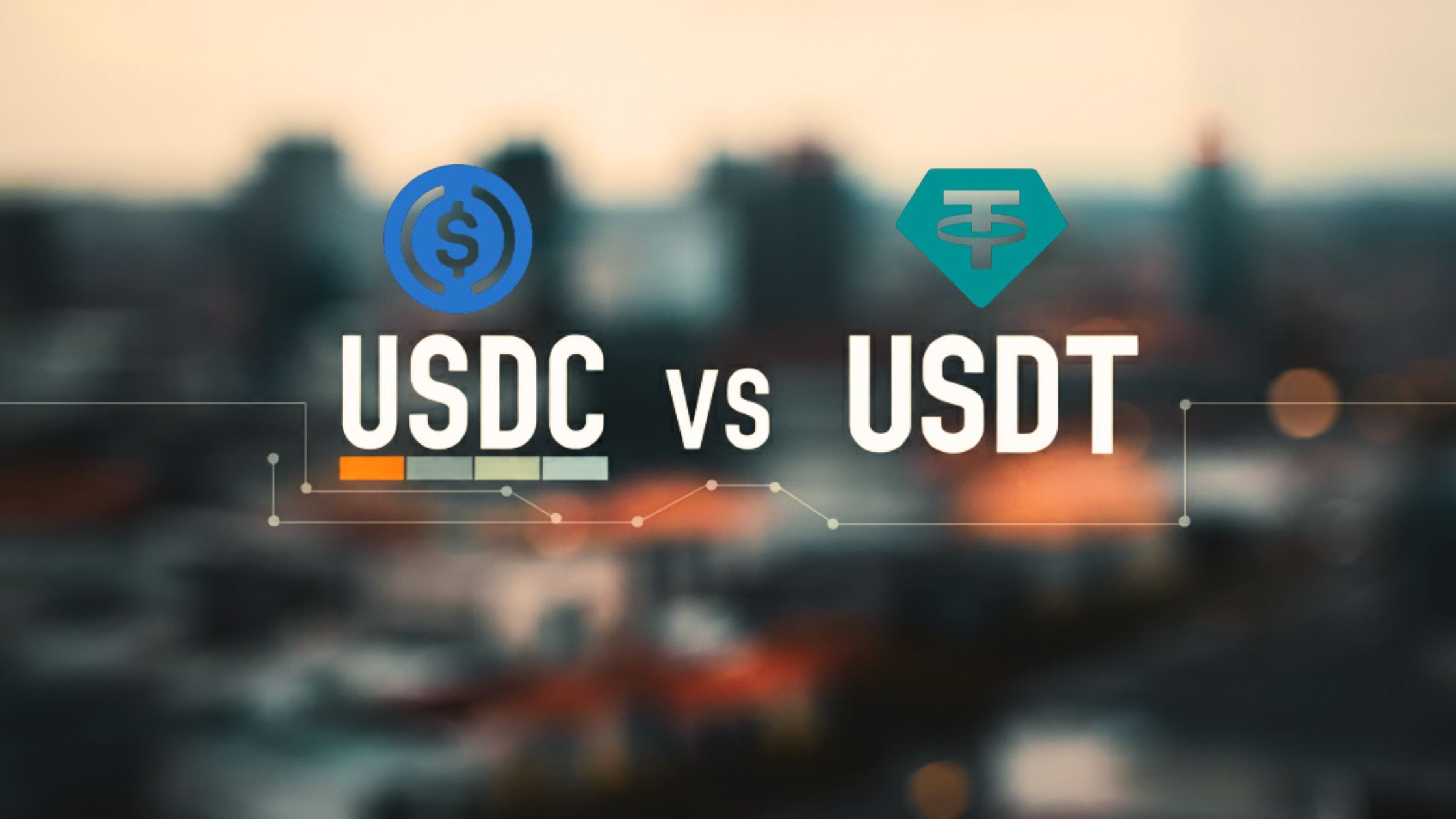What is USDC vs USDT? USDC (USD Coin) and USDT (Tether) are two popular stablecoins that are pegged to the US dollar, but that’s where the similarities end.
In this article, we’ll explain the differences between USDC and USDT, exploring their unique characteristics, advantages, and disadvantages. Whether you’re a seasoned crypto enthusiast or new to stablecoins, understanding the distinctions between USDC and USDT is crucial for making informed decisions.
USDC vs USDT, which is better?
USDC (USD Coin) and USDT (Tether) offer unique advantages. Choosing between them depends on your individual needs and priorities. Let’s go deeper into the characteristics of each.
USDC
USDC, backed by Coinbase and Circle, offers:
1. Transparent and audited reserves: USDC’s reserves are held in segregated accounts and regularly audited by Grant Thornton, providing users with assurance that their funds are fully backed.
2. Faster settlement times: USDC transactions typically settle faster than USDT, making it ideal for time-sensitive applications.
3. Wide acceptance in DeFi platforms: USDC is widely accepted in decentralized finance (DeFi) platforms, allowing users to easily lend, borrow, and trade.
USDT
On the other hand, USDT boasts:
1. Larger market capitalization and liquidity: USDT has a larger market capitalization and is more widely traded, making it easier to buy and sell.
2. Longer track record (launched in 2014): USDT has been around longer, establishing itself as a trusted stablecoin.
3. Wide acceptance on exchanges: USDT is listed on numerous exchanges, providing users flexibility and convenience.
USDC vs USDT
When choosing between USDC and USDT, consider your priorities:
1. Transparency and trust: If assurance and transparency are crucial, USDC’s audited reserves and clear governance make it the better choice.
2. Liquidity and market presence: If ease of trading and wider acceptance are essential, USDT’s larger market capitalization and longer track record give it an edge.
3. DeFi platform compatibility: For DeFi enthusiasts, USDC’s wide acceptance makes it the go-to stablecoin.
4. Trading pair availability: If you prioritize trading flexibility, USDT’s wider availability on crypto exchanges is advantageous.

USDT vs USDC, which is safer?
Both USDT and USDC are considered safe stablecoins, but they have different risk profiles. Here’s a detailed comparison:
USDT (Tether)
Risk: Higher
Concerns
1. Lack of transparency in reserve audits: Tether’s reserve audits have been inconsistent and lacking in detail, raising concerns about the backing of USDT.
2. Controversies surrounding reserve backing: Questions have been raised about whether USDT is fully backed by US dollars, with some allegations of fractional reserve banking.
3. Centralized governance: Tether’s governance is controlled by a single entity, potentially leading to centralized decision-making and increased risk.
Pros
1. Longer track record (launched in 2014): USDT has been around longer, establishing itself as a trusted stablecoin in the market.
2. Larger market capitalization and liquidity: USDT’s larger market presence provides more stability and easier trading.
USDC (USD Coin)
Risk: Lower
Advantages
1. Transparent and audited reserves: USDC’s reserves are regularly audited, assuring that funds are fully backed.
2. Clear governance and regulatory compliance: USDC prioritizes regulatory compliance and has a clear governance structure, reducing legal risks.
3. Decentralized governance: USDC’s governance is decentralized, allowing for community involvement and reducing the risk of centralized control.
Pros
1. Faster settlement times: USDC transactions typically settle faster than USDT, making it ideal for time-sensitive applications.
2. Wide acceptance in DeFi platforms: USDC is widely accepted in decentralized finance (DeFi) platforms, allowing users to easily lend, borrow, and trade.
Factors to Consider
Consider the following factors to determine which is safer for you:
1. Transparency: USDC’s audited reserves provide more transparency, giving users confidence in the backing of their funds.
2. Governance: USDC’s decentralized governance is considered more secure, reducing the risk of centralized control.
3. Regulatory compliance: USDC prioritizes regulatory compliance, reducing legal risks and potential government intervention.
4. Market presence: USDT’s larger market capitalization and liquidity may provide more stability, but also increases the risk of market manipulation.
USDC is considered the safer option due to its transparency, decentralized governance, and regulatory compliance. However, it is essential to assess your individual needs and priorities, as both stablecoins carry some level of risk.

Is USDC better than USDT?
USDC is considered a better option than USDT for several reasons:
1. Transparency: USDC has transparent and audited reserves, ensuring that funds are fully backed.
2. Governance: USDC has decentralized governance, reducing the risk of centralized control.
3. Regulatory compliance: USDC prioritizes regulatory compliance, reducing legal risks.
4. DeFi acceptance: USDC is widely accepted in DeFi platforms, making it ideal for decentralized finance applications.
5. Faster settlement: USDC transactions settle faster than USDT.
However, USDT has a larger market capitalization and liquidity, making it more widely traded and accepted on exchanges.
Ultimately, the choice between USDC and USDT depends on your individual needs and priorities:
- If transparency, decentralized governance, and regulatory compliance are crucial, USDC is the better choice.
- If liquidity and market presence are more important, USDT might be the better option.
It is essential to assess your specific requirements and risk tolerance before deciding.
Is USDT equal to USDC?
USDT and USDC are similar in that they are both stablecoins pegged to the US dollar but are not equal in terms of their underlying characteristics, risks, and use cases. Here are some key differences:
1. Reserve management: USDC has transparent and audited reserves, while USDT’s reserves have faced scrutiny and controversy.
2. Governance: USDC has decentralized governance, whereas USDT’s governance is more centralized.
3. Regulatory compliance: USDC prioritizes regulatory compliance, whereas USDT has faced regulatory challenges.
4. Adoption: USDT has wider adoption on exchanges and platforms, while USDC is more widely accepted in DeFi applications.
5. Risk profile: USDC is considered to have a lower risk profile due to its transparent reserves and decentralized governance.
While both USDT and USDC are stablecoins, they have distinct differences in design, governance, and risk profile. USDC is not equal to USDT, but rather a distinct alternative with its strengths and weaknesses.

Should I convert my USDT to USDC?
Whether to convert USDT to USDC depends on your individual needs and priorities. Here are some factors to consider:
Pros of converting to USDC
1. Transparency: USDC has transparent and audited reserves, assuring that funds are fully backed.
2. Decentralized governance: USDC’s community-driven governance reduces the risk of centralized control.
3. Regulatory compliance: USDC prioritizes regulatory compliance, reducing legal risks.
4. DeFi compatibility: USDC is widely accepted in DeFi applications, offering more opportunities for lending, borrowing, and trading.
Cons of converting to USDC
1. Liquidity: USDT has wider acceptance on exchanges and platforms, potentially making it easier to trade or withdraw.
2. Fees: Converting USDT to USDC may incur fees, depending on the exchange or platform used.
3. Market volatility: Stablecoins can still be affected by market fluctuations, so timing the conversion is essential.
Consider the following questions
1. Is transparency and decentralized governance crucial for you?
2. Are you involved in DeFi applications or planning to be?
3. Are you willing to accept potential fees for conversion?
4. Have you considered market volatility and timing?
If you value transparency, decentralized governance, and DeFi compatibility, converting USDT to USDC might be suitable. However, if liquidity and market presence are more important, it might be better to hold USDT.
Ultimately, assess your individual needs and priorities before making a decision.
Is USDC a good cryptocurrency?
USDC is considered a reliable and stable cryptocurrency, but whether it’s “good” depends on your needs and priorities. Here are some points to consider:
Pros:
1. Stability: USDC is pegged to the US dollar, maintaining a stable value.
2. Transparency: Regular audits ensure transparent reserves.
3. Decentralized governance: Community-driven decision-making.
4. DeFi compatibility: Widely accepted in decentralized finance applications.
5. Regulatory compliance: Prioritizes compliance with regulatory requirements.
Cons:
1. Limited upside: USDC’s value won’t increase significantly as a stablecoin.
2. Centralized control: While decentralized in governance, USDC is still controlled by a single entity (Circle).
3. Dependence on USD: USDC’s value relies on the US dollar’s stability.
If you prioritize stability, transparency, and DeFi compatibility, USDC might be a good choice. However, you might consider alternative cryptocurrencies if you’re looking for potential upside or a more decentralized asset.

Conclusion
While both USDC and USDT have their strengths and weaknesses, USDC stands out for its transparency, decentralized governance, and DeFi compatibility. However, USDT’s wider acceptance and longer history can’t be ignored.
The choice between USDC and USDT depends on your individual needs, priorities, and preferences. By understanding the differences between these two stablecoins, you’ll be better equipped to navigate the world of cryptocurrency and make informed decisions about your investments.
Remember, USDC vs USDT is more than just a comparison – it’s a choice between two distinct approaches to stablecoins.

Kathy Brooks is a digital marketing specialist at IPB Digital LLC. She is a technical writer that is fascinated with all things blockchain, cryptocurrency, digital assets and web3. Follow IPB Digital LLC on LinkedIn, Facebook and Twitter.

